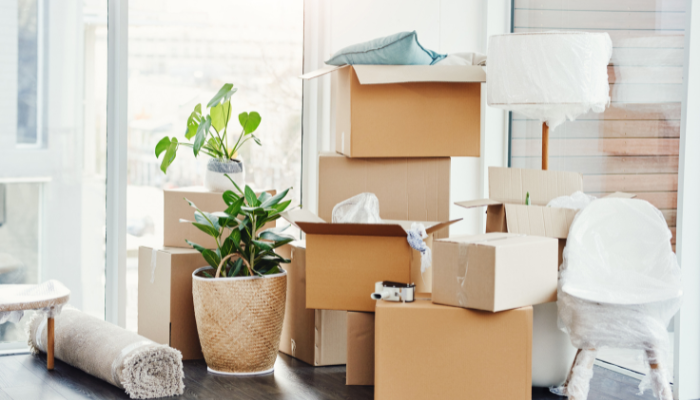Moving to a new home begins another chapter in life’s journey. There’s a fresh canvas awaiting your arrival, and you’re the artist. Still, moving all your possessions from one home to the next feels rather daunting at times.
The tips in this article will help you streamline the moving process, reduce stress, and ensure a smooth transition to your new home.
Getting Started
Keep your moving “to-do” list where it’s instantly available – like on your smartphone, tablet, or laptop. Consider the use of a printable moving checklist to give some structure to the experience. Good Housekeeping organizes tasks on a timeline from eight weeks to one week before moving day.
It’s advisable to contract with a mover and obtain supplies as early as possible. Assemble everything you’ll need, like boxes, large box labels, packing tape, box cutters, and markers for labeling boxes.
Moving Day Tips and Tricks
Prepare for your moving day with systematic packing and decluttering. Put an essentials bag together. Prepare goodies to eat and drink on the big day. Focus on important details like moving insurance and contracts with movers.
1. Embrace the art of systematic packing
Organize now, and enjoy the fruits of your labors in your new home. Create folders containing all your moving information – one written, the other on your computer desktop. Start packing lesser-used items weeks or even months before moving day. Books and out-of-season clothing are prime examples.
Common moving accessories include dollies, furniture pads, and tie-down straps. Generous use of bubble wrap and tape protects valuable assets and family heirlooms. The same is true for your TVs and computer monitors. Pack a large-screen TV in the original box if you still have it. Well-insulated coolers make it easy to transport valuable frozen and refrigerated food.
While large boxes are fine for lighter possessions, avoid filling them with heavy items. Your movers will appreciate the effort. Alternate stacks of framed photos and art with large pieces of cardboard. Big wardrobe boxes may consume space but are a great way to transport clothing.
List the destination on each box: kitchen, living room, etc. Color-coded labels speed up the process. Clearly mark boxes containing fragile possessions. At The Spruce, you’ll find detailed tips for moving various items, like clothing, plates, and books.
2. Make it a time to streamline
Put a positive twist on your move by viewing it as an opportunity to declutter. Periodic decluttering is a good idea anyhow. Determine which items to gift, donate, or toss. Consider a garage sale. Give things away via your local “Buy Nothing” group on Facebook. The Buy Nothing phenomenon now encompasses thousands of local groups in 44 countries.
As for things you need to toss, consider those big, heavy-duty “contractor” bags. Two mils, 55-gallon bags handle all manner of refuse without tearing.
3. Transfer services
Cancel or redirect regularly scheduled deliveries. Change your contact information online with your various insurers and others.
Also, let the post office know you’re moving. At the USPS change-of-address website, you’ll verify your identity ($1.10 fee) and establish the start date for mail delivery at your new home. You can even update your voter registration information. Note that you must appear in person at a USPS facility if you can’t verify your identity online. The same is true if you’re submitting the request on behalf of another person.
Tenants are often responsible for utilities like electricity, natural gas, and cable. Landlords often handle things like sewer and water. Arrange a cancel date for your existing utility services, and designate the start date for utilities at your new apartment home. Take note of every interaction in case anything goes awry. Protect against potential billing discrepancies by taking a photo of the meter as you depart.

4. Assemble a moving essentials bag
Prepare a duffle, backpack, or suitcase that you’ll keep with you at all times. Include things like:
- Medications
- Laptop computer, phone charger, and other electronics
- Toiletries
- Key documents and valuables
- Extra clothes
Have cash with you for tipping movers, paying tolls, buying snacks, and fast food.
5. Prepare food and drink
Stock a moving day cooler with refreshments and sandwiches. High-protein snacks like nuts, protein bars, and trail mix maintain energy levels. It is also a nice gesture to share a drink and a snack or two with your movers.
6. Dress for success
Moving success, that is. There’s no sense in becoming a wounded warrior during the big move. Be proactive by:
- Protecting your feet with closed-toe shoes or non-slip boots.
- Wearing gloves with non-slip grips.
- Minimizing bumps and scrapes with long-sleeved shirts and pants with some heft.
Avoid loose-fitting clothing that could snag on sharp corners. Have some band-aids handy just in case. Watch the weather forecasts from Point A to Point B, and dress accordingly. Prepare for the possibility of precipitation and changing temperatures. Have extra clothes along so you can adapt to varied conditions. Have a fresh change of clothes handy for the end of the day.
7. Consider moving insurance
You may want to consider moving insurance. Understand the difference between release value protection and full value protection.
Release value protection is often offered by your mover at no cost to you, but you must sign for it in advance. Full value protection makes a mover responsible for the full value of any lost or damaged items. The upfront premium payment is typically one to two percent of the value of the property being moved. Be aware of deductibles that may apply.
8. Review the Bill of Lading
A mover’s Bill of Lading is a document listing the goods being shipped and the means of transport. Your mover should complete this contractual document before the loading begins. Think of it as a giant receipt that you’ll want to keep in your possession throughout your move. Moving.com provides more detail about the Bill of Lading.
Throughout the moving process, visualize relaxing in your new living space. Let that image pull you forward to the new and exciting experiences to come.
Luxury Apartment Communities to Consider
Draper and Kramer’s luxury apartment properties are great options to move into. We offer a comprehensive selection of communities with desirable amenities.
At Chicago’s Wrigleyville Lofts, residents savor spectacular views from the rooftop deck. In Austin, TX, the tech district is home to DK Riata, where residents enjoy a two-grill outdoor kitchen and fire pit. In McKinney, TX, there are the Bell Tower Flats at Adriatica. This luxury apartment community includes a resort-style pool with a spa and cabana.
Pet lovers enjoy valued amenities at many D&K properties. In Centennial, CO, The Wright offers a dog park and pet washroom. North of Phoenix, AZ, Senita at Cave Creek features a bark park and dog wash station.
Browse our complete portfolio of properties, including those in metro Chicago, St. Louis, Denver, Dallas-Fort Worth, and Phoenix.

Streamline your moving day with these essential tips for a smoother transition to your new home. From packing strategies to moving day essentials, discover key ways to make your move stress-free.